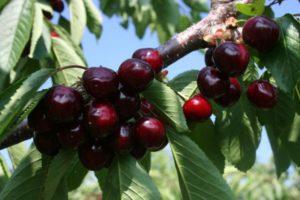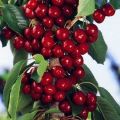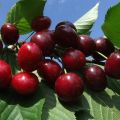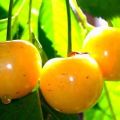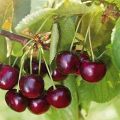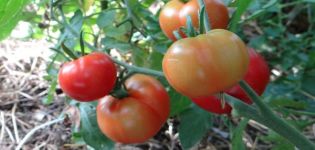Description of the variety and characteristics of the Raditsa cherry, cultivation and care
Lovers of large, tasty and juicy fruits will love the Raditsa cherry. The description of this variety suggests that the tree is capricious, it can hardly endure the winter, but the quality and quantity of the crop fully compensate for all the shortcomings. Experts recommend growing sweet cherries in the Central Region; they are not adapted for a more severe climate.
Content
- 1 How the variety is bred
- 2 Photo and description
- 3 general characteristics
- 3.1 Taste qualities
- 3.2 Content of nutrients
- 3.3 Tree height and growth rate
- 3.4 Flowering and ripening period
- 3.5 Yield
- 3.6 Transportability
- 3.7 Drought tolerance
- 3.8 Frost resistance
- 3.9 Resistance to coccomycosis, moniliosis, clasterosporium
- 3.10 Fruit application
- 3.11 Basic soil requirements
- 3.12 Preferred climate
- 4 How to choose a seedling
- 5 Landing time and scheme
- 6 Care
- 7 Prevention of diseases and pests
- 8 Reproduction
- 9 Tips
- 10 Yield
- 11 Additional watering
- 12 Cherry pruning
- 13 Reviews
How the variety is bred
The breeders of the All-Russian Research Institute of Lupin worked on the breeding of the Raditsa cherry. The merit of obtaining a new variety belongs to M.V. Kanshina, who crossed the Kommunarka and Leningradskaya black, beloved by gardeners. In 2001, Raditsa was registered in the State Register and recommended for planting in the Central Region.
Photo and description
The description of the Raditsa variety allows you to highlight the characteristic features inherent in this particular cherry and allow you to distinguish it from other similar varieties.
general description
The variety is mid-season, very productive. The tree grows rapidly, quickly gains height and reaches 4 m in height. The crown is oval, not very thickened, well leafy. The fruits are red, tasty, with excellent commercial characteristics.
Bud
The bud of a sweet cherry is of a generative type, large in size, resembling a cone in shape. She is strongly rejected from escaping.
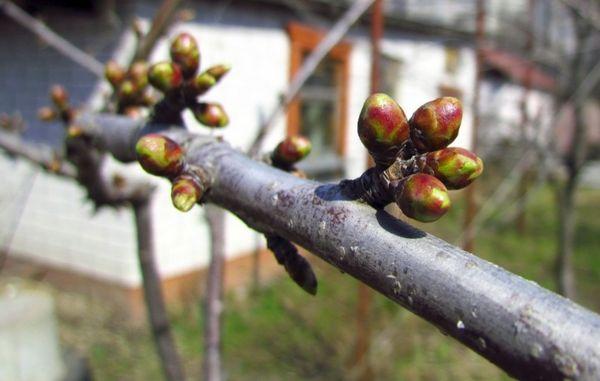
Leaf and flower
Raditsa's leaf is obovate, slightly elongated. Its color is bright green, notches are clearly visible at the edges, the base is rounded. The inflorescence contains 3 separate flowers with petals of a snow-white color. The anthers and stigma of the pistil are at the same level, the cup is of the goblet type.
Fetus
Cherry Raditsa is famous for its fruits, for the sake of which it is settled in their gardens by both amateurs and professionals.
Weight
Depending on the growing conditions, the weight of the Raditsa fruit is 4.6-5.7 g.
Height
The height of the cherry fruit is 2.5-3 cm.
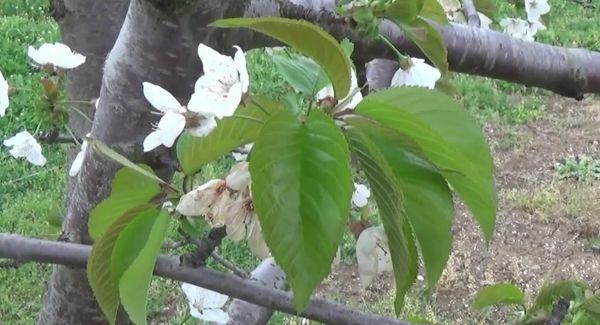
Width
The width of the Raditsa berry reaches 2.5-2.8 cm.
Thickness
Of the total volume of cherries, only 5.2% is per bone, therefore the berry is fleshy, with a thick layer of pulp.
Color
When ripe, the pulp of the fruit acquires a dark scarlet color, and the skin becomes red-black.
Peduncle
Raditsa's peduncle is small, pigmented, divided into 3 glands.

Bone
The stone is small, has a beige color, takes up a little more than 5% of the total fruit.
general characteristics
Raditsa belongs to mid-season high-yielding varieties with fruits of universal application. The crop is distinguished not only by its high taste, but also by its commercial characteristics. Cherries contain:
- sugar - 11.2%;
- acid - 0.4%;
- dry matter - 16.1%.
For every 100 g of the product, there is approximately 13.5 mg of ascorbic acid. The fruits are not prone to cracking.
Taste qualities
Sweet cherries taste sweet, tasters rated their quality 4.5 points.

Content of nutrients
The composition of sweet cherry fruits contains a large number of nutrients:
- vitamin C;
- thiamine;
- vitamin A;
- B vitamins;
- calcium;
- iron;
- phosphorus;
- zinc;
- potassium;
- beta-carotene.
Tree height and growth rate
Raditsa is growing rapidly and rapidly. The maximum height of an adult tree reaches 4 m.
Flowering and ripening period
Sweet cherry begins to bear fruit 4 years after planting a seedling in the garden. Fruit ripening occurs simultaneously. Flowering begins in the first half of May, and the harvest ripens by mid-June.
Yield
Raditsa is considered a high-yielding variety, producing about 60 centners of ripe cherries from each hectare of planting.

Transportability
The pulp of medium density provides the fruit with good transportability.
Drought tolerance
The variety is not considered drought tolerant and needs regular watering. At the same time, the tree does not tolerate stagnant moisture.
Frost resistance
Cherry Raditsa is a frost-resistant variety that can withstand temperatures down to -29 ° C in winter. When this indicator is exceeded, the tree freezes by 1.5 points. In the case of return frosts in spring, the yield decreases by 56%.
Resistance to coccomycosis, moniliosis, clasterosporium
Raditsa has an increased resistance to coccomycosis and moniliosis, as well as an average immunity to clasterosporiosis.

Fruit application
Sweet cherries are suitable for fresh consumption, as well as various types of processing:
- preparation of tincture;
- homemade wine making;
- preparation of compotes;
- preparation of jam;
- cooking jam;
- making jelly;
- conservation;
- freezing;
- drying.
Basic soil requirements
Sweet cherry Raditsa prefers light, fertile loamy or sandy loam soil with good air permeability for planting. This variety should not be planted in areas dominated by clay, sand or peat. The groundwater level should not approach the surface by more than 2 m.
Preferred climate
Raditsa is excellent for cultivation in temperate climates. Also, the tree feels good in the gardens of the Moscow region.
How to choose a seedling
A real Raditsa seedling should have a noticeable grafting site, which indicates that the plant is really varietal. The sweet cherry chosen for planting has a main trunk thickness of about 17 cm.
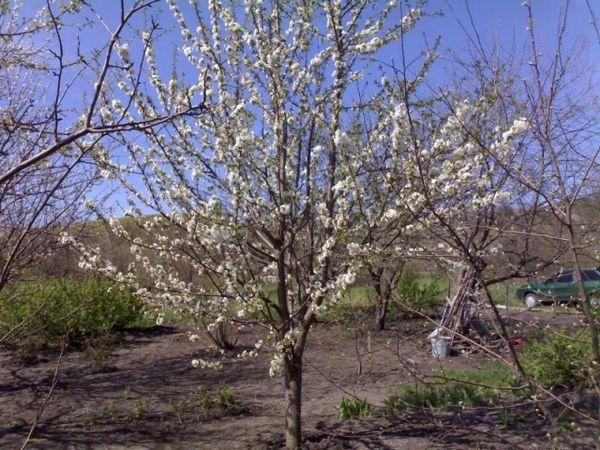
Preference should be given to a seedling 1-2 years old, on which there are at least 3-4 branches about 0.4 m long. A tree with two trunks under the weight of the crop can easily break. The root system should not be too dry. Cherry is selected without mechanical damage, broken shoots or signs of disease.
Landing time and scheme
The planting of Raditsa cherries is planned for the spring. Work is carried out before the buds begin to bloom on the seedlings, that is, almost immediately after the snow begins to melt.The distance between adjacent fruit trees or shrubs and planted cherries is about 4 m.
Before planting, the cherry roots are dipped into a root formation stimulator for 10 hours, after which the damaged roots are carefully trimmed. A wooden peg is driven into the prepared planting hole, a tree is installed and the root system is carefully straightened, after which the hole is covered with earth. The root collar must necessarily protrude 4 cm above the ground surface.
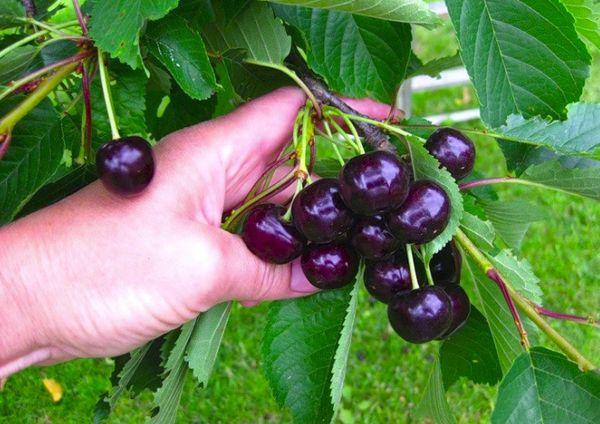
Pit preparation
They begin to prepare a planting pit for cherries in the fall. During this period, the necessary fertilizers are embedded, in particular superphosphate, so that they have time to dissolve before spring.
It is recommended to add a little lime or dolomite flour to the acidic soil, and then dig up the area. After 14 days, a hole is dug about 0.8 m wide and at least 0.5 m deep. A couple of buckets of compost or humus are added to the upper fertile layer of earth, and another 1 kg of wood ash is added in the spring. From the resulting mixture, a tubercle is formed at the bottom of the landing hole.
You should not be too zealous with fertilizers, so that the cherries do not give an excessive growth of branches, which will not have time to ripen during the season and will die in winter.
Care
To obtain a high-quality and bountiful harvest, Raditsa cherries require proper care and adherence to agrotechnical conditions.
Top dressing and watering
Sweet cherries need feeding only 2 years after planting. Until this period, she has enough nutrients and fertilizers that were introduced into the soil during planting. At the beginning of spring, nitrogen is introduced under the tree, and at the beginning of autumn, they begin to prepare it for wintering. For this purpose, superphosphate is embedded in the soil.
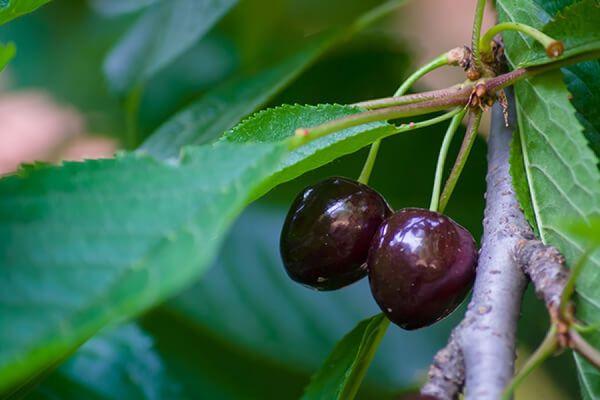
To ensure good yields, Raditsu is fed with green fertilizers. Lupine, vetch or sainfoin are best suited for these purposes. They are sown in the near-stem circle of cherries in early summer. It is advisable to plant nearby vegetation that attracts bees for pollination. With the onset of autumn, the entire green cover is mowed and buried in the ground for decay and fertilization.
Cherry Raditsa does not belong to drought-resistant crops, therefore it requires regular watering. The seedlings are watered a couple of times a month. Before the onset of cold weather, the soil in the periosteal circle is thoroughly watered again so that the root system does not freeze.
A mature tree is irrigated 4 times during the growing season. In the fall, the tree needs weekly watering. If flowering occurs during a dry period, then more moisture will be required.
Weeding and loosening
Immediately after planting, weeds are regularly removed around the cherries. After each watering or heavy rainfall, it is necessary to loosen the soil, renew the mulch layer.
Crown formation
When forming the crown of the Raditsa cherry, it is taken into account that the trunk should rise 20 cm above the skeletal branches.When spring comes, all annual shoots are removed. The bottom tier should contain 3 skeletal branches. At a height of 0.7 m from it, the next tier is formed from 3 more processes. When cherries reach the age of more than 5 years, they only need sanitary pruning, which means removing frozen or damaged shoots.

Pollinators
Raditsa belongs to self-fertile varieties and requires the obligatory planting of nearby pollinators. Therefore, experienced gardeners are advised to plant several more varieties nearby:
- Jealous;
- Tyutchevka;
- Iput.
It is also possible to plant cherries near Raditsa with an early flowering period, which can also serve as pollinators.
Prevention of diseases and pests
Despite the increased resistance to diseases, the Raditsa cherry requires timely preventive measures against some pathogens of diseases and pests that can harm the plant.
"Confidor"
As a preventive measure, as well as to combat aphid infestation, it is recommended to spray cherries with the "Confidor" preparation.The first time it is used until the buds begin to bloom, and then after 14 days. It is recommended to add a little soap solution to the product to stick better to the wood.
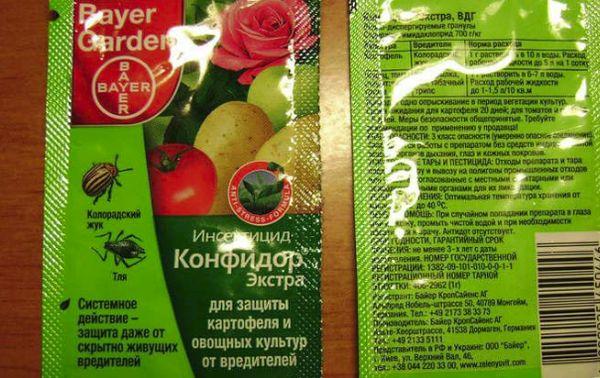
A solution of tobacco dust from parasites
To combat aphids, an aqueous solution of tobacco dust is also effectively used in early spring. Due to the fact that foliage on the trees is almost absent during this period, it is also recommended to add a little soap to it to increase adhesion to the branches.
Cherry fly traps
The cherry fly is a lot of trouble, therefore, special traps with a yellow color are effectively used to combat it. Hang them up until the flower buds begin to bloom. You can purchase such a device at a gardening store.
"Nitrafen" from moths
Gardeners use the drug "Nitrafen", which is sold in specialized stores, to combat moths. It is bred according to the attached instructions, and the treatment is carried out before the kidneys begin to swell.

Bird net
In order to protect the crop from the invasion of birds during the formation of ovaries and ripening of fruits, gardeners throw a fine fishing net or mesh material specially purchased for these purposes on cherries.
Spring processing
With the onset of spring heat, the Raditsa cherry requires preventive treatments and measures. In particular, the tree trunk must be whitewashed with a mixture made from clay, lime and water. Also at this time of the year, spraying with the preparation "Inta-Vir", as well as "Urea" is carried out, diluting 300 g of the purchased powder in a bucket of water.
Preparing for winter
With the onset of the first frost, the Raditsa cherry sapling must be covered. Previously, a frame is built around it, and then agrofiber or spunbond is thrown over. At the bottom, the material is pressed down with stones or bricks. With the onset of spring heat, the shelter is immediately removed so that the cherry does not trample.
Cherry pruning
Sanitary pruning of Raditsa cherries is carried out in the spring, before the budding begins. At this time, all damaged shoots are removed from the tree, as well as those that have not survived the winter and are frozen over. It is also necessary to cut out the processes growing inside the crown.

Reproduction
Cherry varieties Raditsa reproduce in three main ways:
- vaccinations;
- seeds;
- cuttings.
Experienced gardeners claim that the most effective method is grafting. To implement it, you will need a cutting and a ready-grown stock. Cuttings are preferably cut in the fall and stored in a cool place. As a rootstock, I use root shoots, as well as seedlings of any kind. For better survival, the scion and rootstock are selected of the same diameter at the cut.
For propagation of cherries using cuttings, planting material is harvested, which are twigs with growth buds about 0.3 m long. They are placed in a root formation stimulator for 12 hours and planted in a previously prepared greenhouse.
Further care consists in constant watering and maintaining the temperature regime at +25 ° C.
Cherry seeds are propagated only for the sake of growing a high-quality rootstock. In this way, it is impossible to obtain a tree with the same characteristics as the parent plant. Very often, the fruits of such plants are inedible and unattractive. But the grown stock will be compatible with any other variety.
Tips
Experienced gardeners have already gained some experience in the cultivation and care of Raditsa cherries. Some of their advice turns out to be very valuable.

Yield
In order for the yield of sweet cherries to be at a high level, another pollinator variety must necessarily grow nearby. Otherwise, waiting for a rich harvest will not work.The tree loves soil with a low level of acidity, therefore, care should be taken to deoxidize the soil and add a small amount of lime to it. Do not forget about timely feeding. With a lack or excess of nutrients, cherries can shed some of the ovaries.
Additional watering
During flowering and fruit formation, the tree needs additional watering. They should be stopped as soon as the cherries begin to ripen. Otherwise, the crop can crack and deteriorate right on the tree. If the fall is dry, then additional irrigation will also be needed at this time so that the plant can endure the winter well.
Cherry pruning
To increase the yield of cherries, it is also recommended to pinch the ends of young shoots as soon as they reach a length of 0.6 m.This technique will make the crown thicker and provoke the formation of a large number of fruit buds.
Reviews
During the existence of the Raditsa cherry variety, gardeners learned from their own experience about all its advantages and disadvantages. They share their impressions with colleagues.
Natalya Mikhailovna: “I have been engaged in the selection of cherries for my garden for a long time and considered several options. Raditsa attracted attention because the varietal characteristics promised good fruit taste and early ripening. Together with her, she acquired another variety with a similar flowering period for pollination. I must admit that I got the harvest quite early. In the conditions of the Moscow Region, the family ate red cherries in mid-June. We managed to remove 6 harvest buckets from a mature tree. The berries had an excellent taste, grew dense and juicy. We even managed to make small preparations for the winter. "
Vitaly Anatolyevich: “I chose Raditsa for my garden on the advice of friends. I did not need a pollinator, since a tree with similar flowering periods grows behind the fence. The seedling began to bear fruit 4 years after planting. Now the plant is already mature and gives stable high yields. Due to its high resistance to disease, there is no need for constant chemical treatments. Under the tree, the wife plants various flowers with a pungent smell to repel pests. There are enough sweet cherries not only to provide for a family of 4 during the ripening period, but also to prepare a small amount of canning and freezing for the winter. "
Angelina Dmitrievna: “Raditsa remained on my site from the previous owners, along with the pollinator. Our family liked the variety, so we did not uproot it. Every spring, the tree pleases with lush flowering, and with the beginning of summer it is possible to pamper yourself with fresh tasty fruits. We do not make preparations for the winter; we treat our friends and acquaintances with surplus cherries. We do not have enough time for leaving, therefore we limit ourselves to watering and seasonal fertilization, and also carry out sanitary pruning in the spring. We carry out the treatment for diseases and pests once, as soon as the heat comes. We are using Inta-Vir ”.
Alexandra Nikolaevna: “Raditsa acquired cherries at the fair, drawing attention to its varietal characteristics. However, at that time, I did not attach importance to the fact that the tree definitely needs a pollinator variety. When the seedling grew up, and it was time to harvest, almost no fruit was set, although the flowering was abundant. Frustrated, I wanted to remove the tree from my garden. However, an acquaintance helped with advice.
She, as it turned out, has also been growing the same variety for a long time and gives abundant harvests. Only now a friend grows several varieties of cherries at once, and there are several cherries in the garden. It is they who serve as pollinators for Raditsa. After listening to the advice, I decided to give my tree a second chance and planted another sweet cherry and an early cherry nearby.A few years later, the tree was rehabilitated in my eyes and pleased with a rich harvest of beautiful cherries with excellent taste, which both adults and children were happy about. "
